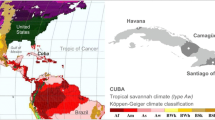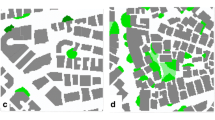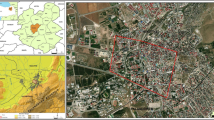Abstract
In order to contribute to the sustainability of the outdoor environment, knowledge about the urban thermal bioclimate should be transferred into climatic guidelines for planning. The general framework of this study responds to the need of analyzing thermal bioclimate in Mediterranean climate regions and its influence as an urban design factor. The paper analyzes the background of the urban climate and thermal bioclimate conditions in Barcelona (Spain), through the effect of shade conditions and wind speed variations. Simulations of shade and wind speed variations were performed to evaluate changes in thermal bioclimate due to modifications in urban morphology. Air temperature, relative humidity, wind speed, and solar radiation for the period from January, 2001 to January, 2015 were used to calculate physiologically equivalent temperature (PET) using the RayMan model. The results demonstrate that shade is the most important strategy to improve urban microclimatic conditions. In Barcelona, human thermal comfort conditions can be improved by shade and wind speed increase in terms of PET above 23 °C and by a wind speed decrease for thresholds of PET below 18 °C. Heat stress situations can be mitigated by shade and wind speed increase in conditions above 35 and 45 °C, respectively. The results of the study are an important contribution for urban planners, due to their possibilities and potential for the description of microclimatic conditions in Mediterranean climate regions. The knowledge is useful for improved human thermal comfort conditions, from the suitable configuration of urban form and architecture.





Similar content being viewed by others
References
Abreu L, Labaki L, Matzarakis A (2014) Thermal bioclimate as a factor in urban and architectural planning in tropical climates—the case of Campinas, Brazil. Urban Ecosyst 17:489–500. doi:10.1007/s11252-013-0339-7
Ali-Toudert F, Mayer H (2006) Numerical study on the effects of aspect ratio and orientation of an urban street canyon on outdoor thermal comfort in hot and dry climate. Build Environ 41:94–108. doi:10.1016/j.buildenv.2005.01.013
Ali-Toudert F, Mayer H (2007) Effects of asymmetry, galleries, overhanging façades and vegetation on thermal comfort in urban street canyons. Sol Energy 81:742–754. doi:10.1016/j.solener.2006.10.007
Andreou E (2013) Thermal comfort in outdoor spaces and urban canyon microclimate. Renew Energy 55:182–188. doi:10.1016/j.renene.2012.12.040
Bourbia F, Boucheriba F (2010) Impact of street design on urban microclimate for semi arid climate (Constantine). Renew Energy 35:343–347. doi:10.1016/j.renene.2009.07.017
Cohen P, Potchter O, Matzarakis A (2013) Human thermal perception of Coastal Mediterranean outdoor urban environments. Appl Geogr 37:1–10. doi:10.1016/j.apgeog.2012.11.001
Deb C, Ramachandraiah A (2010) The significance of physiological equivalent temperature (PET) in outdoor thermal comfort studies. Int J Eng Sci Technol 2:2825–2828
Edussuriya P, Chan A, Ye A (2011) Urban morphology and air quality in dense residential environments in Hong Kong. Part I: district-level analysis. Atmos Environ 45:4789–4803. doi:10.1016/j.atmosenv.2009.07.061
Emmanuel R, Johansson E (2006) Influence of urban morphology and sea breeze on hot humid microclimate : the case of Colombo, Sri Lanka. Clim Res 30:189–200
Fröhlich D, Matzarakis A (2013) Modeling of changes in thermal bioclimate: examples based on urban spaces in Freiburg, Germany. Theor Appl Climatol 111:547–558. doi:10.1007/s00704-012-0678-y
Givoni B (1989) Urban design in different climates. World Meteorological Organization
Givoni B (1994) Urban design for hot humid regions. Renew Energy 5:1047–1053. doi:10.1016/0960-1481(94)90132-5
Gómez F, Pérez A, Valcuende M, Matzarakis A (2013) Research on ecological design to enhance comfort in open spaces of a city (Valencia, Spain). Utility of the physiological equivalent temperature (PET). Ecol Eng 57:27–39. doi:10.1016/j.ecoleng.2013.04.034
Hang J, Sandberg M, Li Y, Claesson L (2009) Pollutant dispersion in idealized city models with different urban morphologies. Atmos Environ 43:6011–6025. doi:10.1016/j.atmosenv.2009.08.029
Herrmann J, Matzarakis A (2012) Mean radiant temperature in idealised urban canyons–examples from Freiburg, Germany. Int J Biometeorol 56:199–203. doi:10.1007/s00484-010-0394-1
Hien N, Kardinal S, Imam N, et al. (2011) Evaluation of the impact of the surrounding urban morphology on building energy consumption. Sol Energy 85:57–71. doi:10.1016/j.solener.2010.11.002
Höppe P (1999) The physiological equivalent temperature in an universal index for the biometeorological assessment of the thermal environment. Int J Biometeorol 43:71–75. doi:10.1007/s004840050118
Johansson E (2006) Influence of urban geometry on outdoor thermal comfort in a hot dry climate: a study in Fez, Morocco. Build Environ 41:1326–1338. doi:10.1016/j.buildenv.2005.05.022
Johansson E, Emmanuel R (2006) The influence of urban design on outdoor thermal comfort in the hot, humid city of Colombo, Sri Lanka. Int J Biometeorol 51:119–133. doi:10.1007/s00484-006-0047-6
Ketterer C, Matzarakis A (2014) Human-biometeorological assessment of heat stress reduction by replanning measures in Stuttgart, Germany. Landsc Urban Plan 122:78–88. doi:10.1016/j.landurbplan.2013.11.003
Kottek M, Grieser J, Beck C, et al. (2006) World map of the Köppen-Geiger climate classification updated. Meteorol Zeitschrift 15:259–263. doi:10.1127/0941-2948/2006/0130
Krüger E, Minella F, Rasia F (2011) Impact of urban geometry on outdoor thermal comfort and air quality from field measurements in Curitiba, Brazil. Build Environ 46:621–634. doi:10.1016/j.buildenv.2010.09.006
Kuttler W (2000) Stadtklima. In: Handbuch der Umweltveränderungen und Ökotoxologie, Band 1B: Atmosphäre. Springer-Verlag, pp 420–470
Labaki L, Fontes M, Bueno C, Dacanal C (2012) Thermal comfort in public open spaces: studies in pedestrian streets in Sao Paulo state. Brazil Ambient Construido 12:167–183
Lai D, Guo D, Hou Y, et al. (2014) Studies of outdoor thermal comfort in northern China. Build Environ 77:110–118. doi:10.1016/j.buildenv.2014.03.026
Lau KK-L, Lindberg F, Rayner D, Thorsson S (2014) The effect of urban geometry on mean radiant temperature under future climate change: a study of three European cities. Int J Biometeorol 799–814. doi:10.1007/s00484-014-0898-1
Lin TP (2009) Thermal perception, adaptation and attendance in a public square in hot and humid regions. Build Environ 44:2017–2026. doi:10.1016/j.buildenv.2009.02.004
Lin TP, Matzarakis A (2008) Tourism climate and thermal comfort in Sun Moon Lake, Taiwan. Int J Biometeorol 52:281–290. doi:10.1007/s00484-007-0122-7
Lin TP, Matzarakis A (2011) Tourism climate information based on human thermal perception in Taiwan and Eastern China. Tour Manag 32:492–500. doi:10.1016/j.tourman.2010.03.017
Lin TP, Matzarakis A, Hwang R, et al. (2010) Shading effect on long-term outdoor thermal comfort. Build Environ 45:213–221. doi:10.1016/j.buildenv.2009.06.002
Lin TP, Tsai K, Hwang R, Matzarakis A (2012) Quantification of the effect of thermal indices and sky view factor on park attendance. Landsc Urban Plan 107:137–146. doi:10.1016/j.landurbplan.2012.05.011
Lindberg F, Grimmond CSB (2011) The influence of vegetation and building morphology on shadow patterns and mean radiant temperatures in urban areas: model development and evaluation. Theor Appl Climatol 105:311–323. doi:10.1007/s00704-010-0382-8
Makaremi N, Jaffar Z, Salleh E, Matzarakis A (2012) Study on outdoor thermal comfort in hot and humid context. International Conference on Urban Climates. Dublin Ireland, In, pp. 8–11
Matzarakis A (2014) Transfer of climate data for tourism applications—the Climate-Tourism/Transfer-Information-Scheme. Sustain Environ Res 24:273–280
Matzarakis A, Alcoforado M (2010) Planning with urban climate in different climatic zones. Geographicalia 57:5–39
Matzarakis A, Mayer H, Iziomon MG (1999) Applications of a universal thermal index: physiological equivalent temperature. Int J Biometeorl 43:76–84
Matzarakis A, Mayer H (1996) Another kind of environmental stress: thermal stress. WHO Collaborating Centre for Air Quality Management and Air Pollution Control NEWSLETTERS No. 18:7–10
Matzarakis A, Mayer H (1997) Heat stress in Greece. Int J Biometeorol 41:34–39
Matzarakis A, Endler C, Nastos PT (2014) Quantification of climate-tourism potential for Athens, Greece—recent and future climate simulations. Glob Nest J 16:43–51
Matzarakis A, Najjar G, De Rocco M (2009) Thermal bioclimate in Strasbourg—the 2003 heat wave. Theor Appl Climatol 98:209–220. doi:10.1007/s00704-009-0102-4
Matzarakis A, Rutz F, Mayer H (2007) Modelling radiation fluxes in simple and complex environments—application of the RayMan model. Int J Biometeorol 51:323–334. doi:10.1007/s00484-006-0061-8
Matzarakis A, Rutz F, Mayer H (2010) Modelling radiation fluxes in simple and complex environments: basics of the RayMan model. Int J Biometeorol 54:131–139. doi:10.1007/s00484-009-0261-0
Mayer H, Höppe P (1987) Thermal comfort of man in different urban environments. Theor Appl Climatol 38:43–49
Nakamura Y, Oke TR (1988) Wind, temperature and stability conditions in an east-west oriented urban canyon. Atmos Environ 22:2691–2700
Ndetto EL, Matzarakis A (2013a) Basic analysis of climate and urban bioclimate of Dar es Salaam, Tanzania. Theor Appl Climatol 114:213–226. doi:10.1007/s00704-012-0828-2
Ndetto EL, Matzarakis A (2013b) Effects of urban configuration on human thermal conditions in a typical tropical African coastal city. Adv Meteorol. doi:10.1155/2013/549096
Oke TR (1973) City size and the urban heat island. Atmos Environ 7:769–779
Oke TR (1982) The energetic basis of the urban heat island. Q J R Meteorol Soc 108:1–24
Oke TR (1984) Methods in urban climatology. Appl Climatol 14:19–29
Oke TR (1988) Street design and urban canopy layer climate. Energy Build 11:103–113
Pantavou K, Santamouris M, Asimakopoulos D, Theoharatos G (2014) Empirical calibration of thermal indices in an urban outdoor Mediterranean environment. Build Environ 80:283–292. doi:10.1016/j.buildenv.2014.06.001
Pantavou K, Theoharatos G, Santamouris M, Asimakopoulos D (2013) Outdoor thermal sensation of pedestrians in a Mediterranean climate and a comparison with UTCI. Build Environ 66:82–95. doi:10.1016/j.buildenv.2013.02.014
Rodríguez Algeciras JA, Coch H, De la Paz Pérez G, et al (2015) Human thermal comfort conditions and urban planning in hot-humid climates—The case of Cuba. Int J Biometeorol. doi:10.1007/s00484-015-1109-4
Rosselló-Nadal J (2014) How to evaluate the effects of climate change on tourism. Tour Manag 42:334–340. doi:10.1016/j.tourman.2013.11.006
Roth M (2007) Review of urban climate research in (sub)tropical regions. Int J Climatol 1873:1859–1873. doi:10.1002/joc
Serra R, Coch H (1991) Architecture and natural energy. Barcelona
Spagnolo J, De Dear R (2003) A human thermal climatology of subtropical Sydney. Int J Climatol 23:1383–1395. doi:10.1002/joc.939
Tablada A, De la Peña A, De Troyer F (2005) Thermal comfort of naturally ventilated buildings in warm-humid climates : field survey. In: The 22nd Conference on Passive and Low Energy Architecture. Beirut, Lebanon
VDI (1998) Methods for the human biometeorological evaluation of climate and air quality for the urban and regional planning. Part I: climate. VDI guildline 3787. Part 2. Berlin, Beuth
Yang W, Wong NH, Zhang G (2013) A comparative analysis of human thermal conditions in outdoor urban spaces in the summer season in Singapore and changsha, China. Int J Biometeorol 57:895–907. doi:10.1007/s00484-012-0616-9
Zaninović K, Matzarakis A (2009) The bioclimatological leaflet as a means conveying climatological information to tourists and the tourism industry. Int J Biometeorol 53:369–374. doi:10.1007/s00484-009-0219-2
Acknowledgments
This work was supported by the University of Camagüey-Cuba and Department of Architectural Constructions of the Superior Technical School of Architecture of Barcelona (ETSAB). We would like to thank Abel José Rodríguez Algeciras for providing language help and for proof reading. Our thanks also to Oriol Baylina and the Meteorological Service of Catalonia for allowing us access to the climate data used in this study.
Author information
Authors and Affiliations
Corresponding author
Rights and permissions
About this article
Cite this article
Rodríguez Algeciras, J.A., Matzarakis, A. Quantification of thermal bioclimate for the management of urban design in Mediterranean climate of Barcelona, Spain. Int J Biometeorol 60, 1261–1270 (2016). https://doi.org/10.1007/s00484-015-1121-8
Received:
Revised:
Accepted:
Published:
Issue Date:
DOI: https://doi.org/10.1007/s00484-015-1121-8




